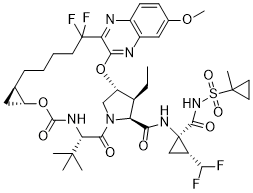Voxilaprevir (formerly GS-9857; GS9857; trade name: Vosevi) is a hepatitis C virus nonstructural protein (HCV NS) 3/4A protease inhibitor developed by Gilead and approved in 2017 as an anti-HCV drug for use in combination with sofosbuvir and velpatasvir.
Physicochemical Properties
| Molecular Formula | C40H52F4N6O9S | |
| Molecular Weight | 868.94 | |
| Exact Mass | 868.345 | |
| Elemental Analysis | C, 55.29; H, 6.03; F, 8.75; N, 9.67; O, 16.57; S, 3.69 | |
| CAS # | 1535212-07-7 | |
| Related CAS # |
|
|
| PubChem CID | 89921642 | |
| Appearance | White to off-white solid powder | |
| Density | 1.4±0.1 g/cm3 | |
| Index of Refraction | 1.596 | |
| LogP | 3.83 | |
| Hydrogen Bond Donor Count | 3 | |
| Hydrogen Bond Acceptor Count | 15 | |
| Rotatable Bond Count | 9 | |
| Heavy Atom Count | 60 | |
| Complexity | 1780 | |
| Defined Atom Stereocenter Count | 8 | |
| SMILES | S(C1(C)CC1)(NC([C@]1(C[C@H]1C(F)F)NC([C@@H]1[C@H](CC)[C@@H]2CN1C([C@H](C(C)(C)C)NC(=O)O[C@@H]1C[C@H]1CCCCC(C1C(=NC3C=C(C=CC=3N=1)OC)O2)(F)F)=O)=O)=O)(=O)=O |
|
| InChi Key | MZBLZLWXUBZHSL-FZNJKFJKSA-N | |
| InChi Code | InChI=1S/C40H52F4N6O9S/c1-7-22-27-19-50(28(22)32(51)48-39(18-23(39)31(41)42)35(53)49-60(55,56)38(5)14-15-38)34(52)30(37(2,3)4)47-36(54)59-26-16-20(26)10-8-9-13-40(43,44)29-33(58-27)46-25-17-21(57-6)11-12-24(25)45-29/h11-12,17,20,22-23,26-28,30-31H,7-10,13-16,18-19H2,1-6H3,(H,47,54)(H,48,51)(H,49,53)/t20-,22-,23+,26-,27+,28+,30-,39-/m1/s1 | |
| Chemical Name | (33R,34S,35S,91R,92R,5S)-5-(tert-butyl)-N-((1R,2R)-2-(difluoromethyl)-1-(((1-methylcyclopropyl) sulfonyl)carbamoyl)cyclopropyl)-34-ethyl-14,14-difluoro-17-methoxy-4,7-dioxo-2,8-dioxa-6-aza-1(2,3)-quinoxalina-3(3,1)-pyrrolidina-9(1,2)-cyclopropanacyclotetradecaphane-35-carboxamide | |
| Synonyms | GS-9857; GS 9857; GS9857; trade name: Vosevi | |
| HS Tariff Code | 2934.99.9001 | |
| Storage |
Powder-20°C 3 years 4°C 2 years In solvent -80°C 6 months -20°C 1 month |
|
| Shipping Condition | Room temperature (This product is stable at ambient temperature for a few days during ordinary shipping and time spent in Customs) |
Biological Activity
| Targets | Hepatitis C virus (HCV) nonstructural protein (NS) 3/4A protease |
| ln Vitro | For the HCV encoded polyprotein (intomature forms of NS3, NS4A, NS4B, NS5A, and NS5B proteins) to be cleaved by protease and subsequently for viral replication, NS3/4A protease is required[1]. utilizing isogenic NS4A peptide cofactors supplied in trans and recombinant NS3 protease domains in enzymatic assays. Voxilaprevir has Ki values of 0.038 nM and 0.066 nM, respectively, against the NS3 proteases of HCV genotypes 1b and 3a[1].in stable cell lines that express HCV replicons that encode renilla luciferase (Huh-7-Lunet or Huh7-1C cells). Across genotypes 1 through 6, vitilaprevir demonstrates strong pangenotypic antiviral activity, with an EC50 ranging from 0.33 to 6.6 nM. Voxilaprevir has IC50 values of 0.33 nM, 3.9 nM, 3.3 nM, 3.7 nM, 4.5 nM, 1.8 nM, and 6.6 nM, 1.9 nM against HCV replicon strains DQ314805, H77, Con1, JFH-1, J6, J8 (full length), and HM568433, SA13 (NS3 Chimera), respectively[1]. |
| ADME/Pharmacokinetics |
Absorption, Distribution and Excretion When provided as the fixed dose combination product Vosevi with [DB08934] and [DB11613], voxilaprevir reaches a maximum concentration (Cmax) of 192 ng/mL at a maximum time (Tmax) of 4 hours post-dose. Voxilaprevir is primarily eliminated via biliary excretion. Metabolism / Metabolites Voxilaprevir is primarily metabolized by Cytochrome P450 3A4 (CYP3A4) and to a lesser extent by CYP2C8 and CYP1A2. Biological Half-Life 33 hr |
| Toxicity/Toxicokinetics |
Effects During Pregnancy and Lactation ◉ Summary of Use during Lactation Voxilaprevir has not been studied in nursing mothers being treated for hepatitis C infection. Because it is greater than 99% bound to maternal plasma proteins, amounts in breastmilk are likely to be very low. Some sources recommend against breastfeeding when voxilaprevir is used with ribavirin. Hepatitis C is not transmitted through breastmilk and breastmilk has been shown to inactivate hepatitis C virus (HCV). However, the Centers for Disease Control recommends that mothers with HCV infection should consider abstaining from breastfeeding if their nipples are cracked or bleeding. It is not clear if this warning would apply to mothers who are being treated for hepatitis C. Infants born to mothers with HCV infection should be tested for HCV infection; because maternal antibody is present for the first 18 months of life and before the infant mounts an immunologic response, nucleic acid testing is recommended. ◉ Effects in Breastfed Infants Relevant published information was not found as of the revision date. ◉ Effects on Lactation and Breastmilk Relevant published information was not found as of the revision date. Protein Binding Voxilaprevir is more than 99% bound to human plasma proteins. |
| References |
[1]. Expert Opin Pharmacother.2018 May;19(7):749-757. [2]. J Viral Hepat. 2016 Aug;23(8):614-22. [3]. Gastroenterology. 2016 Nov;151(5):893-901.e1. |
| Additional Infomation |
Pharmacodynamics Voxilaprevir is a direct-acting antiviral agent that targets viral NS3/4A protein and causes a decrease in serum HCV RNA levels. It disrupts HCV replication by specifically inhibiting the critical functions of NS3/4A protein in the replication complex. It does not appear to prolong the QT interval even when given at 9 times the maximum recommended dose. |
Solubility Data
| Solubility (In Vitro) | DMSO : ≥ 100 mg/mL (~115.08 mM) |
| Solubility (In Vivo) |
Solubility in Formulation 1: ≥ 2.5 mg/mL (2.88 mM) (saturation unknown) in 10% DMSO + 90% Corn Oil (add these co-solvents sequentially from left to right, and one by one), clear solution. For example, if 1 mL of working solution is to be prepared, you can add 100 μL of 25.0 mg/mL clear DMSO stock solution to 900 μL of corn oil and mix evenly. (Please use freshly prepared in vivo formulations for optimal results.) |
| Preparing Stock Solutions | 1 mg | 5 mg | 10 mg | |
| 1 mM | 1.1508 mL | 5.7541 mL | 11.5083 mL | |
| 5 mM | 0.2302 mL | 1.1508 mL | 2.3017 mL | |
| 10 mM | 0.1151 mL | 0.5754 mL | 1.1508 mL |
